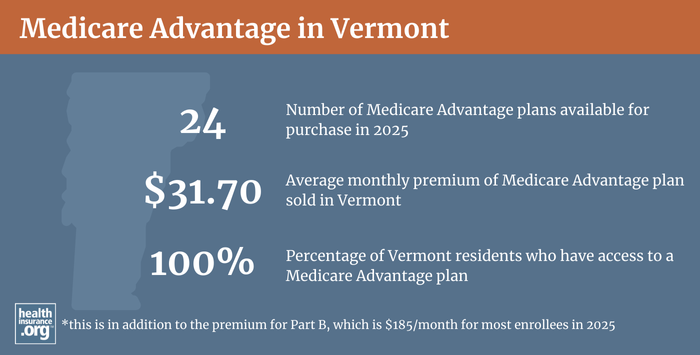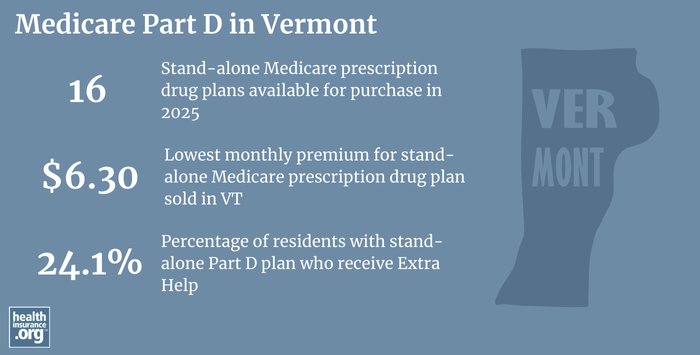
Medicare in Vermont
Original Medicare, Medicare Advantage, Part D prescription drug, and Medigap coverage in Vermont
Key takeaways
- More than 165,000 residents are enrolled in Medicare in Vermont.1
- About 33% of Vermont’s Medicare Beneficiaries are enrolled in Medicare Advantage plans; the rest have Original Medicare1
- Medicare Advantage plan availability in Vermont varies by county.2
- For 2025 coverage, there are 16 stand-alone Medicare Part D plans available in Vermont, with premiums starting at $6.30 per month.3

Vermont Medicare enrollment
Nationwide, over 67 million people are enrolled in Medicare,1 which amounts to about 18% of the total U.S. population.4 As of September 2024, there were 165,412 Vermont residents covered by Medicare in Vermont.5
Most people attain Medicare eligibility in Vermont when they turn 65, but Medicare enrollment also provides coverage for nearly 10 million disabled Americans under the age of 65. Nationwide, about 11% of Medicare beneficiaries are under age 65;1 in Vermont, it’s roughly the same, at a little under 12%.5
Learn about Medicare plan options in Vermont by contacting a licensed agent.



Explore our other comprehensive guides to coverage in Vermont

The ACA Marketplace allows individuals and families to shop for and enroll in ACA-compliant health insurance plans. Subsidies may be available based on household income to help lower costs.


Hoping to improve your smile? Dental insurance may be a smart addition to your health coverage. Our guide explores dental coverage options in Vermont.


Learn about Vermont’s Medicaid expansion, the state’s Medicaid enrollment and Medicaid eligibility.


Short-term health plans provide temporary health insurance for consumers who may find themselves without comprehensive coverage. Learn more about short-term plan availability in Vermont.

Frequently asked questions about Medicare in Vermont
What is Medicare Advantage?
Nationwide, hlaf of all Medicare beneficiaries had Medicare Advantage plans as of late-2024.1 But in Vermont, just 33% of the state’s Medicare beneficiaries were enrolled in Advantage plans at that point.5
Medicare Advantage plans are provided by private insurers, so plan availability varies by area. Vermont has 14 counties, and the number of available Medicare Advantage plan options for 2025 varies from 5 to 7, depending on the county.2
Medicare Advantage plans provide all of the benefits of Medicare Part A (hospital coverage) and Part B (outpatient/medical coverage), and most plans also incorporate Part D coverage (prescription drugs) as well as extra benefits like dental and vision coverage, gym memberships, and a nurse hotline. But out-of-pocket costs (deductible, coinsurance, copays) vary under Advantage plans, and are not the same as a person would have under Medicare Part A and B plus a Medigap plan. There are pros and cons to each option, and no single solution that works for everyone.
Medicare beneficiaries can switch from Original Medicare to Medicare Advantage enrollment, and vice versa, during the annual election period each fall (October 15 through December 7), with coverage effective January 1. There is also a Medicare Advantage open enrollment period (January 1 to March 31) during which people who are already enrolled in Medicare Advantage plans can switch to a different Medicare Advantage plan or drop their Medicare Advantage plan and enroll in Original Medicare instead.
Read our comprehensive guide to Medicare’s fall open enrollment period.

What is Medigap?
Original Medicare does not have a cap on out-of-pocket costs (coinsurance and deductibles), so people with chronic conditions can incur substantial out-of-pocket medical costs. Employer-sponsored plans or Medicaid serve as supplemental coverage for more than half of all Medicare beneficiaries nationwide, but for those who don’t have access to those plans, Medigap plans (also known as Medicare supplements or MedSupp plans) are an important part of having full coverage. Medigap plans are designed to supplement Original Medicare, covering some or all of the out-of-pocket costs (for coinsurance and deductibles) that people would otherwise incur if they only had Original Medicare on its own. Medigap plans cannot be used in conjunction with Medicare Advantage plans.
There are 13 insurers that offer Medigap plans in Vermont in 2025.6 On the Vermont Department of Financial Regulation’s website, you’ll find an extensive guide that provides information about Medigap plans in the state.
According to an AHIP analysis, there were 51,784 Vermont Medicare beneficiaries with Medigap plans as of 2022.7
Medigap plans are standardized under federal rules, so Plan A offers the same covered benefits regardless of which insurer offers it, as does Plan G, Plan K, etc. (premiums vary significantly from one insurer to another, as do things like customer service and additional benefits beyond the standardized benefits, such as a 24-hour nurse hotline). But Medigap standardization means that plan comparisons are easier than they are in other insurance markets.
In most states, Medigap plans can be priced using attained-age rating (rates increase as the enrollee gets older), issue-age rating (rates are based on the age the person was when they enrolled), or community rating (rates do not vary based on age). Vermont does not allow Medigap insurers to use attained-age rating (see Section 15(F) of the state statute), and instead requires community rating as long as the enrollee is at least 65 years old (very few states require this; Vermont’s consumer protection is strong in terms of rating rules). So in Vermont, rates for a given plan only vary based on whether the enrollee is under 65 or 65+ (Vermont is also one of only two states where insurers offering non-Medicare individual market coverage are also required to charge the same price regardless of how old an enrollee is).
Under federal rules, people are granted a six-month window during which they can enroll in a Medigap plan regardless of their medical history. This window starts when they’re at least 65 and enrolled in Medicare Part B. Federal rules do not, however, guarantee access to a Medigap plan if you’re under 65 and eligible for Medicare as a result of a disability.
To address this, the majority of the states have implemented rules ensuring at least some access to Medigap plans for people who are under age 65, and Vermont is among them. Vermont requires Medigap insurers to make all of their plans available to Medicare beneficiaries, regardless of age, during the first six months after the person is enrolled in Medicare Part B.
It’s important to note, however, that Vermont’s guaranteed-issue provision does not apply to people under 65 who are eligible for Medicare due to end-stage renal disease. But Vermont’s legislature is considering a bill in 2023 that would eliminate the exception for people with ESRD. If enacted, it would ensure that these beneficiaries have access to Medigap plans during the six-month window when they first enroll in Medicare.
Although Medigap plans are guaranteed-issue for people under 65 during their six-month enrollment window, insurers can charge higher premiums for people under 65.
Disabled Medicare beneficiaries have access to the normal Medigap open enrollment period when they turn 65. At that point, they have access to any of the available Medigap plans, at the standard age-65+ rates.
Disabled Medicare beneficiaries, including those with ESRD, have the option to enroll in a Medicare Advantage plan instead of Original Medicare. Medicare Advantage premiums are not higher for those under 65. But Advantage plans have more limited provider networks than Original Medicare, and total out-of-pocket costs can be as high as $9,350 per year for in-network care in 2025,8 plus the out-of-pocket cost of prescription drugs.
What is Medicare Part D?
Original Medicare does not cover outpatient prescription drugs. Many Medicare beneficiaries have supplemental drug coverage from an employer or Medicaid, but for those who don’t, Medicare Part D enrollment is an important part of having full coverage. Medicare Part D was created under the Medicare Modernization Act of 2003, and can be purchased on a stand-alone basis or as part of a Medicare Advantage plan with integrated Medicare Part D enrollment coverage.
As of September 2024, 81,049 Vermont Medicare beneficiaries had stand-alone Medicare Part D prescription drug plans, and another 51,255 had Part D coverage integrated with their Medicare Advantage coverage.1 In total, about 80% of Vermont’s Medicare beneficiaries had Part D coverage, either as a stand-alone plan or as part of an Advantage plan.1
For 2025 coverage, there are 16 stand-alone Medicare Part D plans available in Vermont, with premiums starting at $6.30 per month.3

What additional resources are available for Medicare beneficiaries and their caregivers in Vermont?
Questions about Medicare in Vermont? You can also contact the Vermont State Health Insurance Program, which serves as a resource for Medicare beneficiaries in the state. They can help with questions related to Medicare enrollment, eligibility, or coverage in Vermont.
The Vermont Department of Financial Regulation, Insurance Division, oversees and licenses health insurance companies (including those that offer private Medicare plans in Vermont), brokers, and agents in Vermont. They can answer questions, provide information, and address consumer complaints about entities licensed under their authority.
The Medicare Right Center is a nationwide service, offering a website and call center, where Medicare beneficiaries and their caregivers can get information, assistance, and answers to questions.
Medicare beneficiaries with fairly low income and assets can get assistance through Vermont’s Medicaid program. This overview of the available programs is a good resource.
Louise Norris is an individual health insurance broker who has been writing about health insurance and health reform since 2006. She has written dozens of opinions and educational pieces about the Affordable Care Act for healthinsurance.org.

Looking for more information about other options in your state?
Need help navigating health insurance options in Vermont?
Explore more resources for options in VT including ACA coverage, short-term health insurance, dental and Medicaid.
Speak to a sales agent at a licensed insurance agency.
Footnotes
- “Medicare Monthly Enrollment – US” Centers for Medicare & Medicaid Services Data, November 2024. ⤶ ⤶ ⤶ ⤶ ⤶ ⤶ ⤶
- ”Medicare Advantage 2025 Spotlight: First Look” KFF.org Nov. 15, 2024 ⤶ ⤶
- ”Fact Sheet: Medicare Open Enrollment for 2025” (137) Centers for Medicare & Medicaid Services. Sep. 27, 2024 ⤶ ⤶
- U.S. Census Bureau Quick Facts: United States & Vermont.” U.S. Census Bureau, July 2024. ⤶
- “Medicare Monthly Enrollment – Vermont.” Centers for Medicare & Medicaid Services Data. Accessed January, 2025. ⤶ ⤶ ⤶
- “Explore your Medicare coverage options.” Medicare.gov. Accessed October, 2024. ⤶
- ”The State of Medicare Supplement Coverage” AHIP. May 2024 ⤶
- ”Final Contract Year (CY) 2025 Standards for Part C Benefits, Bid Review and Evaluation” Centers for Medicare & Medicaid Services. May 6, 2024 ⤶

